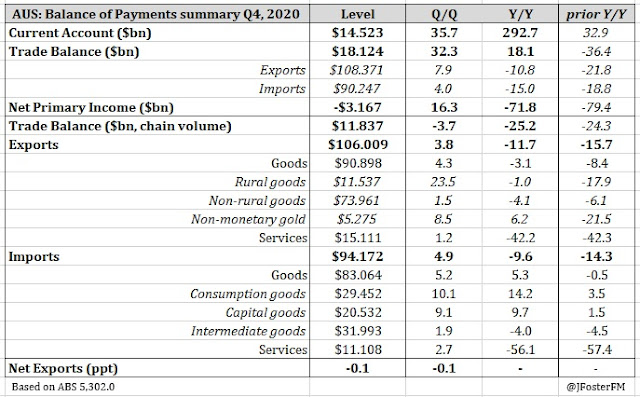This morning the ABS published the last of the remaining inputs before tomorrow's December quarter national accounts. Net exports are set to subtract 0.1ppt from quarterly GDP growth, though public demand will likely add 0.3ppt to activity.
Balance of Payments - Government Finance — Q4 | By the numbers- Australia's current account stayed in surplus for a 7th consecutive quarter, widening to $14.5bn in Q4 from $10.7bn and came in higher than expected ($13.0bn).
- The trade surplus rebounded by $4.4bn in Q4 to $18.1bn, helped by strength in commodity prices.
- The income deficit widened to $3.2bn in Q4 from $2.7bn.
- Net exports are expected to subtract 0.1ppt from GDP growth in Q4 — lower than was expected (-0.3ppt).
- The separate ABS Government Finance data for Q4 reported underlying public demand advanced by 1.1% in Q4 to $130.1bn and is likely to add 0.3ppt to quarterly GDP growth.
Balance of Payments - Government Finance — Q4 | The details
Australia's run of current account surpluses has extended to a 7th consecutive quarter. This is very unusual in a historical context for the nation—indeed the last such stretch of this duration occurred between 1972-73. Driving the current account wider in Q4 was the trade balance, with the surplus there expanding to $18.1bn from 13.7bn in the previous quarter. Export earnings rebounded in Q4 by 7.9% but contracted in the previous 4 quarters, mostly associated with weakness in the global economy due to the pandemic. Import spending advanced by a further 4.0% in Q4 reflecting improving demand conditions with the domestic economic recovery gathering momentum.
Australia's run of current account surpluses has extended to a 7th consecutive quarter. This is very unusual in a historical context for the nation—indeed the last such stretch of this duration occurred between 1972-73. Driving the current account wider in Q4 was the trade balance, with the surplus there expanding to $18.1bn from 13.7bn in the previous quarter. Export earnings rebounded in Q4 by 7.9% but contracted in the previous 4 quarters, mostly associated with weakness in the global economy due to the pandemic. Import spending advanced by a further 4.0% in Q4 reflecting improving demand conditions with the domestic economic recovery gathering momentum.
Adjusting for price movements, export volumes lifted 3.8% in Q4 (-11.7%Y/Y) but were outpaced by a 4.9% rise for imports (-9.6%Y/Y). Exports were supported by increased demand for Australian rural goods (23.5%qtr), while non-rural goods (includes resources commodities) lifted modestly (1.5%qtr). Service exports advanced (1.2%) but remain at a very low level due to the impact of the international border closure.
Imports of goods advanced strongly (5.2%qtr) with gains coming across the board led by consumption (10.1%) and capital goods (9.1%)—both speaking to the effects of rising demand with the recovery in the domestic economy gathering momentum. Services imports lifted 2.7% for the quarter, but as with exports are heavily lower through the year with overseas travel prohibited.
The wider income deficit for Q4 at $3.2bn was driven by weaker returns to domestic investors in offshore markets (-9%), while foreign investors saw returns from Australian assets down 6% in the quarter.
In the December quarter Government Finance data, the ABS reported consumption spending lifted 0.8% in Q4 to $104.6bn and is expected to add 0.2ppt to GDP growth in Q4. Meanwhile, underlying investment was up 2.3% for the quarter to $25.5bn, contributing in the order of 0.1ppt to GDP growth. Based on these gains, public demand was 1.1% higher through Q4 and will add 0.3ppt to quarterly output growth.
Balance of Payments - Government Finance — Q4 | Insights
Today's outturns were a net positive with the subtraction from net exports not as severe as forecast by markets, while public demand is stronger than was being factored in. The momentum in the Australian economy was sustained over the final months of 2020 after activity rebounded by 3.3% on the reopening. Output growth for Q4 is likely to come in around the 2.5-3.0% range.




